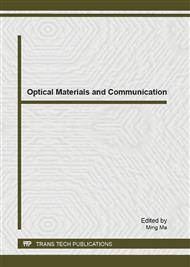[1]
Y. Li, M. A. Malik and P. O. Brien, J. Am. Chem. Soc., Vol. 127 (2005), p.16020.
Google Scholar
[2]
L. Sun, Y. Hao, C. L. Chien et. al., IBM J. Res. Dev., Vol. 49 (2005), P. 79.
Google Scholar
[3]
P. S. Herle, B. Ellis, N. Coombs, and L. F. Nazar, Nat. Mater. Vol. 3(2004), p.147.
Google Scholar
[4]
S. T. Oyama, P. Clark, X. Wang, et. al. J. Phys. Chem. B, Vol. 106(2002), p.1913.
Google Scholar
[5]
S. F. Yang, C. H. Liang and R. Prins, J. Catal., 2006, 241, 465.
Google Scholar
[6]
J. A. Cecilia, A. Molina, E. Castellon , J. Catal., Vol. 263(2009), p.4.
Google Scholar
[7]
Z.L. Wu, F.X. Sun, W.C. Wu, Z.C. Feng, C.H. Liang, Z.B. Wei, C. Li, J. Catal. Vol. 222(2004), p.41.
Google Scholar
[8]
Y.H. Ni, J. Li, L. Zhang, S. Yang, X.W. Wei, Mater. Res. Bull. (2008), Vol. 44(2008), p.1166.
Google Scholar
[9]
C. Stinner, R. Prins, and T. Weber, J. Catal. Vol. 202(2001), p.187.
Google Scholar
[10]
S. T. Oyama, J. Catal. Vol. 216(2003), p.343.
Google Scholar
[11]
S. T. Oyama, X. Wang, Y. K. Lee and W. J. Chun, J. Catal., Vol. 221(2004), p.263.
Google Scholar
[12]
X. Wang, P. Clark and S. T. Oyama, J. Catal., Vol. 208(2002), p.321.
Google Scholar
[15]
C.A. McAuliffe, W. Levason, Phosphine, Arsine and Stibine Complexes of the Transition Elements, Elsevier, Amsterdam, (1979).
Google Scholar
[16]
B. Arinsson, T. Landstrom, S. Rundquist, Borides, Silicides and Phosphides, Willey, New York, (1965).
Google Scholar
[17]
C. Qian, F. Kim, L. Ma, F. Tsui, P. Yang, J. Liu, J. Am. Chem. Soc. Vol. 126 (2004), p.1195.
Google Scholar
[18]
J. Park, B. Koo, K.Y. Yoon, Y. Hwang, M. Kang, J. -G. Park, T. Hyeon, J. Am. Chem. Soc. Vol. 127 (2005), p.8433.
Google Scholar
[19]
A.E. Henkes, R.E. Schaak, Chem. Mater. Vol. 19 (2007), p.4234.
Google Scholar
[20]
J. Liu, X. Chen, M. Shao, C. An, W. Yu and Y. Qian, J. Cryst. Growth, Vol. 252 (2003), p.297.
Google Scholar
[21]
Y. Ni, L. Jin and J. Hong, Nanoscale, Vol. 3(2011), p.196.
Google Scholar


